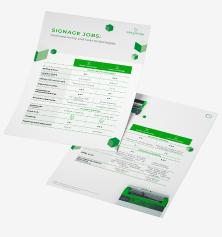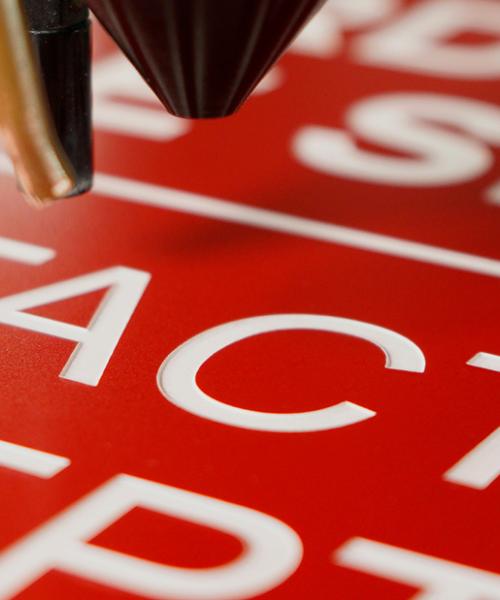What is the best way to make a sign? Between mechanical engraving and laser engraving, it is sometimes difficult to make a choice.
To help you, we offer an overview of these two sign system technologies.
Here are the advantages and disadvantages of each solution to choose the sign engraving machine adapted to your needs for signage, directional signs, normative identification or simple labels.
Rotary sign making machines: strengths and limitations
Gravotech and mechanical engraving: a common history
In 1938 in the United States, the New Hermes company revolutionized the world of engraving by improving a manual engraver (pantograph) complex and fragile: it is the birth of a manual engraving machine, reliable and easy to use.
The company, which became Gravograph (before being called Gravotech), innovated again in the 1960s with the launch of the Gravoply™ sheet, an engraving material specially designed to create contrast in signage with mechanical engraving.

The specificities
With a mechanical sign engraving machine, the cutter digs into the surface to be engraved and creates a furrow: it is therefore not a question of burning but of physically marking the material.
On a mono-layer material, it is impossible to obtain a contrast with such a sign system technology. However, in signage, it is an important issue: to be read quickly and well, from near and far. This is why the Gravoply™ two-layer material was invented. When engraving, the upper layer of an A color reveals the lower layer of a B color, thus creating the contrast sought in signage.
On the metal, you can deposit coloring products or paints (such as Gravolaque or Nitrolaque) in the engraving groove once the engraving is finished to create a sign with color. The professional plates produced in particular for doctors or lawyers are thus engraved, and finalized thanks to the addition of lacquer or oxidation.
Gravotech diversity:
For the creation of your signage, you have the choice between several sizes of CNC sign making machines: from A4 format up to a surface of 1220 x 610 mm (48" x 24") for the largest areas to be engraved. Some sign making machines – such as the large Gravotech ISx000 tables – even allow, thanks to their design, to engrave longer plates in several times.

The benefits
Engraving metal and plastic plates with a CNC sign making machine offers a traditional aspect to the signage, which offers real added value.
The diversity of sign machines thus brings a wide variety of uses.
- Depending on the CNC router size chosen, you can engrave the parts one by one, or start engraving several plates at the same time.
- Thanks to their precision, large CNC sign making machines allow both the cutting of letters or numbers for signs and effect engravings: in 2.5D or intaglio (relief engraving).
- Rotary sign machines are versatile: they allow you to cut on a very wide variety of materials. Mechanical cutters generally produce cuts easier to clean than those made with a laser sign maker. Mechanical machines also allow for pre-cutting, which is particularly appreciated by signage professionals.
- The regulating nose makes it possible to automatically adapt the height of the tool to the surface defects of the part and to ensure regular and precise engraving.
- The M20 type sign machines are desktop, compact engravers: they are the best way to make a sign in small workspaces or shops and are perfect for engraving single plates.
Another great advantage (and not the least), since the engraved material is not burned at the time of engraving, you are not required to provide air treatment in the room where the engraver is located. This also means that a mechanical sign machine can run unattended (in masked time or in the absence of the operator).
Operating without consumables other than the cutting tools used, these mechanical engravers and cutters have relatively low operating costs: the tool is generally changed every 6 months depending on its wear.

The limits
- In use, you should know that the mechanical sign system technology is relatively noisy, and generates shavings requiring suction (automatic or manual). It is also, to a lesser extent, slower than a laser sign maker.
- Such technology is also longer to master: the depth adjustments of the engraving and the regulating nose are done manually.
- As for the result, it is not possible, with a mechanical engraver, to create a sign with natural contrast in a single-layer material sheet (excluding Gravoply™) and without additives (such as lacquer or paint).
Laser engraving: advantages and disadvantages
Gravotech and laser engraving
Created in 1960 by research teams, laser technology is relatively recent. Initially reserved for high-tech industries, it became more democratic with the introduction of small CO2 lasers which made it possible to diversify the applications.
Laser engraving machines today offer different interesting functions such as cutting, in addition to processing organic materials such as plastic, foam, rubber...
Note: laser cutting is of excellent quality. With Gantry machines, for example, large-format letters can be cut with ease to produce clean, smooth edges.

How it works
With a laser sign maker, the surface of the object to be engraved is heated locally by a beam of light which creates a permanent mark in its path by removing a thin layer of material. On metal, there is no material removal (with CO2 technology) as in mechanical engraving.
By using a laser, it is therefore possible to naturally create a sign with contrast on the majority of surfaces, with or without a two-layer material such as Gravoply™. In this case, the engraving is more superficial than with the mechanical sign system technology: the laser remains on the surface. If it is possible to make a deep marking with a laser like in mechanical engraving, it takes much more time.

The advantages
The big advantage of the CO2 laser is its ability to engrave many materials:
- organic (wood, leather, paper, cardboard, rubber);
- mineral (glass, marble, slate);
- plastics (acrylic);
- metallic (metals must however be anodized).
Quieter and much faster, laser sign makers also offer better versatility and more appeal than mechanical engravers for signage creation, thanks to the possibility of working with flexible materials.
A Print and Cut function makes it easy to link a laser engraver and a UV printer. The printed material can be cut precisely around or inside the print.
Also note that getting started with laser engravers is very simple and quick: the laser automatically detects the thickness of the part and makes the adjustments accordingly. Finally, our laser sign machines work without tools or consumables: only changing the extractor filter and cleaning the lens are required for these engraving machines.

The inconvenients
Unlike mechanical engraving solutions, there are no small laser machines. The smallest engraving area size is 610mm x 305mm. Therefore they are not suitable for small shops, and the acquisition cost for such a signage creation machine is high: between 1.5 and 2 times the price of a mechanical engraver.
In addition, the fact that the laser heats the material to be engraved requires a few precautions:
- Depending on the materials to be engraved, it is important to monitor the work to prevent a flame from starting.
- The fumes produced during the etching of the material require an ambient air treatment system.
- For the needs of cutting on plastic materials in your signage creation process, you must use acrylic or PMMA, we do not recommend ABS - which is technically laser cut - because the aesthetic result is very poor (tendency to melt), and the heating of ABS can generate toxic fumes.
Depending on your needs, you can engrave many materials with these two sign system technologies. But the choice of a machine for signage creation will depend on several factors: budget, conditions of use and diversity of activities.

|
Find the summary of this article in a comparative table! It will help you choose the best way to make a sign depending on your situation. |
|---|
Our Solutions
Medium multi-purpose rotary engraving machine for signage and gifts.

M40
Medium CNC engraving machine for flat and cylinder engraving on metal and plastic.

IS400 – IS400 Volume
Large and extra large format CNC engraving machines.

ISx000
Small CO2 laser engraver and cutter for personalization, signage and creative.

LS100
Medium CO2 or Fiber laser engraving and cutting machine for signage and small series.

LS100 EX
Large laser engraver and cutter that can do everything.

